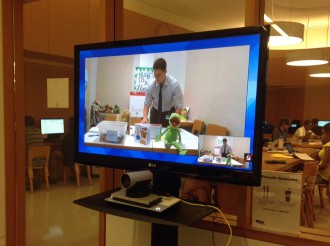Library Outreach Services Helps Families of the Incarcerated Stay Connected

Outreach Services to the Incarcerated
Library outreach services to the incarcerated aren’t just about the people inside the jail. Their children and families benefit from library outreach services as well. Long before our nation’s current shift of attention toward its broken prisons and jails, our leading library systems were focused on serving those in jail and their families within the communities.
Children of the Incarcerated
The National Family Resource Network estimates that there are at least 2 million children with an incarcerated parent. Yet that figure doesn’t count the close to 10 million children who have a parent who is under some form of criminal supervision such as probation or parole. [1]
Nicholas Higgins, Director of Outreach Services at Brooklyn Public Library, was well aware of those figures when he started the “Daddy and Me” program while serving as the “jail” librarian on Rikers Island. That program, which fostered family literacy, included children’s visits with incarcerated fathers at Rikers and DVDs of fathers’ reading aloud books sent home to their children. Suddenly, an incarcerated father didn’t seem so far away, thanks to library outreach services.
Televisit
Now, thanks to Nick’s vision, the BPL, a lot of shared collaboration, and an innovative CISCO telecommunications system called Televisit, those “Daddies” are even closer to home.
Televisit, located at the BPL Central Library branch, is a shared video feed between Rikers Island and BPL where inmates and families participate in a shared family literacy program. It is meant to supplement, not replace, in-person visits.
Having Someone In Jail Is Not Something To Be Ashamed Of
Children, from birth 10 years-old, can participate in “televisits” in one of seven semi-private rooms in the Shelby White and Leon Levy Information Commons at the Central branch of the library. The rooms, filled with Muppets, stuffed animals, books, crayons, and giveaways, are inviting and welcoming. Sesame Street characters from the Little Children, Big Challenges: Incarceration video series have been donated by Lynn Chwatsky along with support material from the program.[2] The Televisit rooms, off to one side, offer privacy, but in no way are hidden—BPL wants to reinforce the message that having a loved one in jail is not something to be ashamed of.
Offering Children of the Incarcerated Support
According to Families Left Behind: The Hidden Costs of Incarceration and Reentry, children of the incarcerated experience PTSD symptoms and experience the same grief as a child who has lost a parent—with good reason, too.[3] The 2013 Sentencing Project Annual Report found that 59% of parents in state prisons and 45% in federal prisons had not had any personal visits with their children while in prison.[4]
And children of the incarcerated receive very little support—often they receive just the opposite—teasing, bullying, shame. Through the Televisit program and BPL’s Children’s Services, the children of the incarcerated are being offered that support.
Televisit Overcomes The Obstacles of Time And Distance
Televisit offers the child and the parent help in overcoming the obstacles that the Women’s Prison Association counts as ways to discourage children from visiting a parent in jail[5]:
- Inadequate information about visiting procedures.
- Difficulty scheduling visits.
- Geographic location of prison facilities.
- Family’s inability to afford transportation.
- Visiting procedures that are uncomfortable or humiliating.
- Visiting rooms that are inhospitable to children.
- Foster parents or caregivers who are unwilling to facilitate visits.
Instead of a “drug dog” sniffing a baby stroller in the visitor’s room, Televisit offers the child both a comfortable, safe, and welcoming environment as well as a shared literacy experience with a parent.
Nick Higgins understands that shared moments between a child, a parent, and a book are ones that a child never forgets and he wants to create those moments despite a parent’s incarceration. He wants to expose both parent and child to the library services available to them at the public library. For both parent and child, this shared moment can be a lifelong learning opportunity.
Library Outreach Services Is Where It All Begins
The touchpoint to the parents and the children is at New York Public Library’s and now Brooklyn Public Library’s collaborative jail book services at Riker’s Island. Outreach library services to the incarcerated, book services, literacy programs, and re-entry information services provide the connection to their families.
The services to the incarcerated at Riker’s along with services to their children and families converge at the intersection of what we call “outreach services.” Televisit is a perfect example of services interfacing with each other in order to fulfill the needs of more than one part of the library community.
No One Forgets Being Read To
Nicholas Franklin, Coordinator of Transitional Services at BPL, recently sat in at Rikers with one of the inmates while the inmate visited via Televisit with his one and a half year old at BPL. She excitedly ran around the Televisit room picking up toys to show her father as he responded: he read her a book, he sang a song, he played peek-a-boo. All the while, other inmates passed by; some correctional officers peeked in. The inmate was as engaged as his daughter, oblivious to his surroundings or any interruptions. Finally, his daughter ran up to the large screen and began to blow kisses at the screen. He blew kisses back.
The inmate’s lack of inhibition and his engagement manifested his concern for his daughter and Franklin observed, “I think this experience helped him realize what a positive effect he could have on her life.”
Televisit and Jail Library Outreach Services
BPL’s Televisit embraces the family’s role in early literacy and embraces the library’s role in re-entry and outreach services to the incarcerated.
Televisit recognizes the stark reality that you don’t have to be arrested to be caught in the cycle of incarceration.
Works Cited
[1] “Parents In Prison.” The Sentencing Project Research and Advocacy for Reform. The Sentence Project. org, n.d. Web. 24 June 2014. <http://www.sentencingproject.org/doc/publications/cc_Parents%20in%20Prison_Factsheet_9.24sp.pdf>.
[2] “Little Children, Big Challenges: Incarceration – Tool Kits – Parents – Sesame Street.” Sesame Street. N.p., n.d. Web. 26 June 2014. <http://www.sesamestreet.org/parents/topicsandactivities/toolkits/incarceration>.
[3] Travis, Jeremy, Elizabeth Cincotta McBride, and Amy Solomon. “FAMILIES LEFT BEHIND: THE HIDDEN COSTS OF INCARCERATION AND REENTRY.” Urban Institute Policy Brief Two (2005): n. pag. Annie E Casey Foundation. Web. 26 June 2014.
[4] “Parents In Prison.” The Sentencing Project Research and Advocacy for Reform. The Sentence Project. org, n.d. Web. 24 June 2014. <http://www.sentencingproject.org/doc/publications/cc_Parents%20in%20Prison_Factsheet_9.24sp.pdf>.
[5] Travis, Jeremy, Elizabeth Cincotta McBride, and Amy Solomon. “FAMILIES LEFT BEHIND: THE HIDDEN COSTS OF INCARCERATION AND REENTRY.” Urban Institute Policy Brief Two (2005): n. pag. Annie E Casey Foundation. Web. 26 June 2014.
Tags: adult programming, children's programming, community services, families, incarcerated adults, library outreach, library services to incarcerated persons








